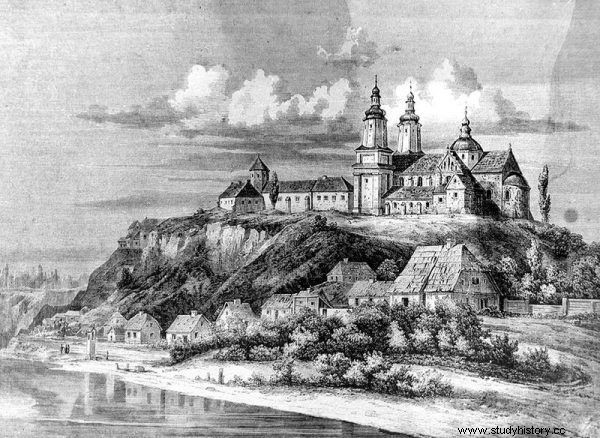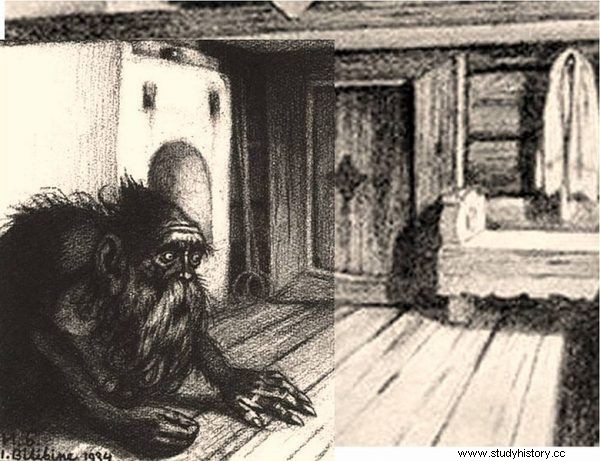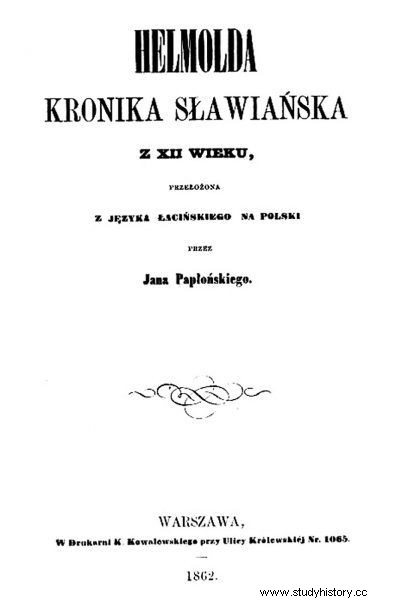Wreaths on the water on Kupała Night, sacred groves, haircuts of adolescent boys - these are typical ideas about the rituals of ancient Slavs living on the Vistula and Oder. The romantic vision of the customs and religion of our ancestors was shaped by literary works, including the famous "Old Fairy Tale". But were the deities worshiped by the Slavs really content with such "nice" rites? Not necessarily. The records of chroniclers and archaeological research indicate that the Slavic gods wanted human, including children's, blood ...
At the beginning there is an important reservation that must be made when writing about the religion of the Slavs. We know almost nothing certain about it. Our ancestors left no written mythology, no epic resembling the Old Germanic Poetic Edda , hence research on the religion of the Slavs is blindfolding. Especially when it comes to the peoples living in the center of present-day Poland. German chroniclers mentioned the religiosity of the Połab and Pomeranian tribes, and there are many sources about Ruthenia. There is hardly any mention of the tribes living in the depths of the dense forests on the Vistula and Odra rivers.
The situation is not improved by the fact that researchers have modest material remains. As Stanisław Urbańczyk colorfully put it:the history of research on the religiosity of the Slavs is a history of disappointments.
Child sacrifice?
Perhaps that is why the discovery from Płock, which was made in 1959, electrified scientists at that time. It seemed as if the researchers had finally found something tangible that to some extent filled the hole of our ignorance.
We are talking about the so-called a pagan wilderness discovered on the Tumskie Hill in Płock. In 1959, excavations began in the courtyard of the former Benedictine abbey, where archaeologists found the remains of the settlement from the 11th century. There was nothing sensational in these finds, but it soon turned out that under the exposed layer there are older traces - from pagan times.
Archaeologist Włodzimierz Szafrański conducted research there. On the basis of material traces, he has developed a hypothesis tailored to a horror movie, which Hollywood would not be ashamed of. Here in Płock there was a pagan place of worship, where a blacksmith - priest made blood sacrifices in front of a statue of a deity.

Płock, Wzgórze Tumskie
Traces indicated that he had sacrificed his horse, but that's not all…. According to the scientist, the deity worshiped in this place wanted human blood and got it - a 12-year-old girl whose head was split open with a stone pestle by a blacksmith ...
What prompted the researcher to forge such a macabre vision?
All that Szafrański found was the remains of a pillar, which he identified as a Slavic idol, i.e. a statue of a deity, and several flat stones surrounded by four semi-circle-shaped pits in the ground, in which there were remains of pottery and animal bones - including the skull of a horse without the mandible, as well as the bone identified as belonging to ... a child. Szafrański decided that the pits in the ground are the remains of candles / sacrificial fires burning during dark rituals. Not far from the cult site, however, he discovered traces of a forge, which suggested that a blacksmith was the priest, sorcerer.
“(...) the Płock wilderness formed a semicircle of four fires-candles in deep pits. In the central part of the fires there was an oval sacrificial altar made of flat fieldstones - wrote in the study of Castrum and Castellum Płockie in the light of excavations.
The blacksmith - a priest (żerca), which was typical of the society of that time, was to offer sacrifices under a square pillar, which, according to the researcher, in the past could also have the image of a deity on its top. A horse's chopped off head could hang from a stone statue.
The sacrifice of a horse as an animal incarnation of the spirit of grain, the god of fertility, would therefore ensure a bountiful harvest. Such sacrifices made in the Płock pagan wilderness would be indicated by horse bones found next to the aforementioned altar, among the bones of sacrificial animals, one of which was even burned in the fire. One can imagine a solemn ritual feast at which an offering was eaten to a deity who was content with the horse's head alone
- the scientist wrote.
A macabre vision, according to which a priest first cuts the throat of an animal, then cuts off its skull, hangs it over the yard or on a pole, and then ritually eats the rest of the animal's body, but that's not all.
At the sacrificial altar, among because a fragment of a 12-year-old girl's skull has just been found. Next to it was a stone ram, possibly a ritual murder weapon.
The aforementioned trace of human blood sacrifice deserves special attention. It was probably made with the help of a stone hammer, abandoned next to it, which was most likely used to crush the bog ore, as a substitute for a blacksmith's hammer. So he could also be used by a sorcerer, a pagan priest, (...) for the ritual killing of the victim
- Szafrański concluded.
Stones pile
The dark vision of bloody pagan rituals that were allegedly performed in Płock did not survive the test of time. Successive researchers who dealt with the topic approached Szafrański's revelation with growing reserve. Today it is recognized that the researcher - to put it mildly - over-interpreted reality.

Reconstruction of the cult circle in the Słowiański Park in Szprotawa. Illustrative photo
Contemporary research, which began in the 1990s, indicates a much less sensational purpose of the discovered elements. It turned out that they were much later than Szafrański thought, often even by a century. The pits in which broken ceramics and bone remains were found, which were to serve as sacrificial candles, were interpreted as ... garbage pits of an early medieval settlement. Its inhabitants disposed of their waste here. The remains of the pillar, which was supposed to be a statue of a deity, are simply a fragment of a medieval building. The sacrificial altar turned out to be nothing more than a random pile of stones.
What about the strongest element of the theory, namely the skull fragment? According to researchers, it could have come from one of the neighboring graves. Right next to the alleged "place of worship", from the end of the 11th to the end of the 18th century, there was a church where the dead were buried all the time. Researchers emphasize that under the entire courtyard of the abbey there are graves and pits where bones from older burials were placed, making room for new ones, and this is probably the origin of this skull.
Sacrifice for a homemaker
Is the refutation of Szafrański's theory also evidence against human sacrifice in our ancestors? Not. There are other indications that something "was up".
We know perfectly well about the so-called in-house sacrifices during the construction of the house. This is one of the most interesting Slavic rituals. Our ancestors believed that human homes are looked after by ghosts, often identified with the dead - the so-called householders. It was them, during the construction of a new house, that the sacrifice had to be made in the corner of the room. It could have been the head of a horse or other killed animal - e.g. a round or a rooster. There was also an offering of eggs or cereals.

An image of a homemaker by Ivan Bilibin (1934)
Is that all? Not necessarily. In Gdańsk, the skeleton of an infant was discovered under the floor of a house from the 12th and 13th centuries. Was it sacrificed? Researchers do not formulate such a bold thesis. This could, for example, be a child who died prematurely, intentionally buried by the parents, etc. A similar discovery was also made in Poznań. A human skull in the foundations of an 8th century house was also found in Santoku.
The blood of a Christian
It is much more certain that Christian missionaries were ritually murdered. Medieval chronicles record that Slavic priests often offered to the gods of clergy trying to convert them to faith in Christ.
Mentions about human sacrifices are provided, among others, by German chronicler Thietmar. He mentions that around 990, after the lost war of the Czech-Great Britain allies (the tribes living between the Oder and the Elbe) with Mieszko I, the Wieleci captured an unknown castle, the leader of which was immediately sacrificed , in order to plead with the gods for a safe way back home.
A form of ritual murder was primarily decapitation (beheading), sometimes combined with truncatio (dismembering or cutting off members). This is how Bishop Jan of Mecklenburg, who set out on a Christianization mission to the Polabian Slavs, died. According to the chronicler Adam of Bremen, in 1066 the bishop was captured in Mechlin (the Slavic Redary town, in today's Mecklenburg in Germany), then taken to the temple in Radogoszcz (today Gross Raden in Germany), which was the main cult site of the Redars. There, when the martyr refused to deny Christ, he was sacrificed. The bishop's head was cut off and his limbs chopped off. His body was abandoned and his head spearheaded and consecrated to a pagan deity.
We also learn about ritual murders from the records of a Saxon clergyman and historian Helmold from Bozów in Wargia (now Bosau - Germany). As a chronicler, he accompanied the German Christianization expeditions in Połabie and Western Pomerania. The author of Chronica Slavorum, or "Chronicles of the Slavs", broadly described the customs of one of the largest port cities of the Slavs, namely Arkona on Rügen:
Also from all Slavic countries [people] come there with questions to the oracles and annual payments for sacrifices. Even merchants who accidentally come to them do not allow them to start trading until they offer the deity something more valuable of their goods.

The Chronicle of the Slavs published in Polish in 1862 in Warsaw, translated by Jan Papłoński.
The chronicler recalls that captured Christian clergymen were willingly chosen as human sacrifices made to Świętowit:
It is even difficult to realize how cruel death they inflicted on Christians:some they threw their entrails on a stake, others nailed to the cross mocking the sign of our Redemption. In their opinion, the greatest criminals should be crucified. And those who are kept alive in the hope of a financial ransom, they torment with such tortures, they bind so strongly with ties that it is simply unbelievable.
Accounts of human sacrifices also concern the Eastern Slavic region. In Novels of Past Years , an Old Russian text describing the history of the state from the very beginning to the 12th century, the narrator mentions that Vladimir the Great, who ruled in Kiev, put up a whole series of pagan idols to whom sacrifices were made. The type of these victims was determined by the fate thrown earlier.
(...) he made idols on the teremny hill (...) and they sacrificed to them, calling them gods, and they brought their sons and daughters to sacrifices to the devils
In turn, the Arab traveler ibn Rosteh mentioned in his notes from the 10th century that the Russians "have doctors who direct their kings as if they were their masters and require them to sacrifice women, men or cattle, of their choice (...). The doctor takes a human or cattle, puts a rope around his neck, fixes it to the board until his soul is torn from it, and says that it is "an offering to God".
The wife under the knife
According to Thietmar, after the death of the man, the Slavic community sacrificed his wife.
They burn their dead because they worship fire. After the funeral of each husband who was burned at the stake, his wife's head was beheaded and thus shared his fate after death.
The problem is that, apart from the records of historians, there are few testimonies that could confirm the fact of murdering people at rituals. Their acquisition is difficult, among others the custom of burning a corpse in the Slavs. In the case of skeletal rituals, the traces are ambiguous and still cause discussions in the scientific community.
Many dismembered bodies were found, for example, in Pomerania. At the excavation sites in the communes of Jabłończyca Wielka (Byków district), in the vicinity of Chojnice, in Kałdus in the commune of Chełmno, in the vicinity of Cedynia, or in Dębczyna in the district of Białogard, graves with fragmented human skeletons, after cutting off the head and limbs and with traces of restraint were discovered .
A sacrifice to the deities, or maybe a cruel sentence on the defeated? There are many such questions.
A similar find concerns the town of Ralswiek in Germany. There, in the area of the beach where, according to researchers, pagan religious ceremonies were to take place, numerous skeletons of sacrificial animals and human bones were found. The theory of the blood sacrifice seems to be confirmed by the fact that these bones bear traces of cuts in the same places (e.g. cuts at the height of joints) as in the case of horses, which - especially in the Polabian Slavs - were considered sacred animals.
However, theories about sacrificial rites are gaining acceptance as well as being rejected by scholars as implausible. They indicate, for example, that decapitation was then simply a form of the death penalty. Without knowledge of the beliefs of our ancestors, theories about human sacrifice - although extremely catchy - are still exaggerated. The secrets of Slavic spirituality still remain hidden from us in the darkness of history.
Bibliography:
- Aleksander Gieysztor, Mythology of the Slavs. Warsaw:1980.
- Lech Leciejewicz, Western Slavs:from the history of the formation of medieval Europe. Wrocław:National Institute for them. Ossoliński, 1989
- Henryk Łowmiański, The Religion of the Slavs and its Fall, PWN, Warsaw 1986
- Jerzy Strzelczyk, Myths, traditions and beliefs of the old Slavs, Poznań 1998;
- Włodzimierz Szafrański, Early medieval pagan cult building in Płock, "Reports on scientific works of the Faculty of Social Sciences of the Polish Academy of Sciences"
- Jan Papłoński, "Helmold's Slavic Chronicle from the 12th Century", Warsaw 1862
- Artur Szyjewski, Religion of the Slavs, Kraków:WAM, 2003
- Thietmar; Chronicle of Thietmar. tr. Marian Zygmunt Jedlicki, MP Krzysztof Ożóg. Krakow:Society of Authors and Publishers of Scientific Papers "Universitas", 2014
- Stanisław Urbańczyk, Old Slavs - faith and worship, Wrocław 1991
- Adam Turasiewicz, Political history of Obodrzyców from the 9th century to the loss of independence in the years 1160 - 1164, Warsaw 2004
